Fingolfen
Well-known member
- Build Rating
- 5.00 star(s)
So, for my first 5E3 build I decided to pretty much go stock - but I may build another with the RobRob mods... though I want to design a custom chassis for that - and I may build it as a head rather than a combo. Enough preamble - on to the pictures!
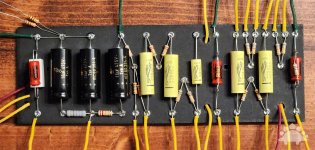
For this build I once again used a bit of a mix of parts. The chassis, eyelet boards, wiring, and many of the small parts are all from Mojotone. I did however decide to splurge for a few of the bits. Where appropriate, I upgraded all of the resistors from carbon composition to carbon film. I also went with my own capacitor choices as well. The electrolytic capacitors are a mix of F&T and Jupiter. The film caps are SoZo NextGen Yellow Mustard Vintage. The tubes (which appear later) are all Tube Amp Doctor. I picked up the resistors, caps, and tubes from Amplified Parts.
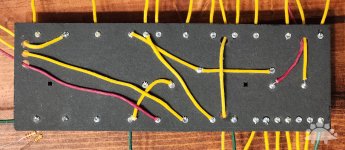
As with my previous amp project, wiring the eyelet board was fairly straightforward - and a lot of fun in a very retro sort of way. One nice thing about the 5E3 project is that it comes with a full set of instructions rather than just the basic documentation (as Mojotone frequently uses this kit in their classes). I picked up a few good tips and tricks from the instructions, but eventually found myself referring to the layout more than the instructions themselves. As you can see from the photo above, there is a little wiring underneath the eyelet board as well.
For the transformers, I also decided to splurge a bit and went with Mercury Magnetics transformers. The power transformer is a FTDP-350 lower B+ transformer, and the output transformer is the modern, rather than vintage, wired version. These generally follow the same wiring conventions and colors as the ones supplied by Mojotone, but they always include the technical specs with the purchase, so it's easy to translate if there is a different colored wire.
As with most transformers you get a fair amount of wire length, so when they're first installed in the amp chassis, you get rainbow spaghetti. In the photo above I've already installed most of the switches, pots, tube sockets, some of the jacks, and the indicator light. The instructions did advise waiting on the input jacks as that end of the board would get very crowded quickly.
Another change this time around is instead of going with the etched indicators like on the Tweed, I designed a custom face plate. This one is a bit more "steampunky" than the original. I had a 5E3 template that I brought into Illustrator to design the plate. Once again, Precision Design came through with an absolutely spectacular job!
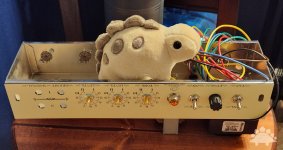
Given how tight the chassis of the narrow panel Tweed amps is, I enlisted Steggi's help to actually get everything wired up!
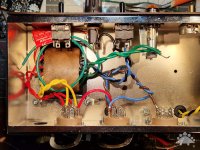
Once all of the major hardware was installed, the long process of wiring began. Once again, the layout was very clear, so figuring out where all of the components needed to be wired in wasn't too bad. I first wired the primary switches, bulbs and power tubes. You'll note that using a modern wiring configuration, what would be the "Standby" switch is not actually wired. So, since it isn't wired, and the standard numbering of the potentiometers on this amp is from 1 to 11, the faceplate allows you to toggle between "SPNL" and "TAP" - yeah, I went there.
Next I wired up the output transformer to the two speaker jacks. This part was pretty straightforward, but then came the marathon of wiring the rest of the individual connections. I didn't take additional photos in this phase, but as you can see from the photo below, there is a LOT of wiring. The ground runs are very long, and I tried to tuck those twisted pairs of wire in toward the top of the chassis.
Once again I tried to keep all of the wiring as clean and neat as possible with any points where the wires crossed kept at right angles - especially for any power connections. This amp also has a ground bus wire running across the potentiometers whereas the 5F2-A did not. I kept my multi-meter handy during the entire process so I could ensure that everything was making proper connection - especially the grounds!
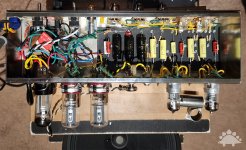
Once everything was complete, I followed the Mojotone instructions for testing the amp - first without tubes and then with tubes. All of the voltages looked very solid so I decided to go ahead and install all of the tubes and give it a whirl... and oh wow... my socks were well and fully blown off! The sound is was amazing - even without being in the cabinet!
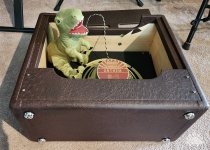
Which brings me to the cabinet for this particular build! My first amp build was very much a "standard" style build. It has the look and feel of the original 5F2-A fender tweed amp. This time I wanted to go with something more "dino like" - at least as much as possible. Mojotone will build you a custom cabinet (and will even provide swatches of the material), so I went through the various options to find a covering that would be something a bit different.
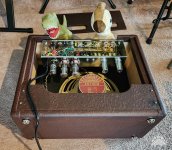
I ultimately settled on using the brown ostrich tolex for the cabinet with a black/red grill cloth. The ostrich pattern looked suitably organic and sort of "dino like" - and the black/red grill cloth seemed to compliment the tolex. The speaker is also from Mojotone, an Anthem 12" 8 Ohm - which Rexie one again helped me install. Once the speaker was installed, I added the chassis screws to the cabinet and Rexie and Perry the Parasaurolophus helped me get it installed. Once I had everything lined up, it was time to tighten everything down!
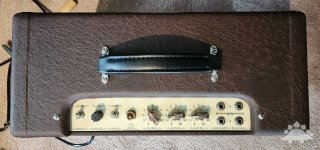
The top view gives you a good look at the awesome face plate. I went ahead and used bronze chicken head knobs for the potentiometers as well as an amber jewel for the indicator light.

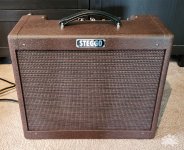
Above are a couple of views of the front and top. I went ahead and added the "Steggo" nameplate like I used on my previous build - also from Precision Designs!
Once it was together, I went ahead and powered it back up to put it through its paces. It's definitely louder than my 5F2-A - but that's unsurprising given the difference in power between the two. The sound at lower volumes is punchy with tons of bass response, but as you increase the volume, it goes into some wonderful breakup providing an amazing rock sound.
This was an amazingly satisfying project, and now I have another amazing amp to add to the collection (this could get addictive). It is possible to buy a new production, hand-wired '57 Custom Deluxe from Fender - but it will set you back $2600. I was able to build this one for probably a third of that. The big test will come this next weekend when I bring it into my favorite local guitar store to face off against the real thing!
Original blog entry (with more pictures and preamble): https://steggostudios.blogspot.com/2024/06/another-amp-project-dino-deluxe-5e3.html

For this build I once again used a bit of a mix of parts. The chassis, eyelet boards, wiring, and many of the small parts are all from Mojotone. I did however decide to splurge for a few of the bits. Where appropriate, I upgraded all of the resistors from carbon composition to carbon film. I also went with my own capacitor choices as well. The electrolytic capacitors are a mix of F&T and Jupiter. The film caps are SoZo NextGen Yellow Mustard Vintage. The tubes (which appear later) are all Tube Amp Doctor. I picked up the resistors, caps, and tubes from Amplified Parts.

As with my previous amp project, wiring the eyelet board was fairly straightforward - and a lot of fun in a very retro sort of way. One nice thing about the 5E3 project is that it comes with a full set of instructions rather than just the basic documentation (as Mojotone frequently uses this kit in their classes). I picked up a few good tips and tricks from the instructions, but eventually found myself referring to the layout more than the instructions themselves. As you can see from the photo above, there is a little wiring underneath the eyelet board as well.
For the transformers, I also decided to splurge a bit and went with Mercury Magnetics transformers. The power transformer is a FTDP-350 lower B+ transformer, and the output transformer is the modern, rather than vintage, wired version. These generally follow the same wiring conventions and colors as the ones supplied by Mojotone, but they always include the technical specs with the purchase, so it's easy to translate if there is a different colored wire.
As with most transformers you get a fair amount of wire length, so when they're first installed in the amp chassis, you get rainbow spaghetti. In the photo above I've already installed most of the switches, pots, tube sockets, some of the jacks, and the indicator light. The instructions did advise waiting on the input jacks as that end of the board would get very crowded quickly.
Another change this time around is instead of going with the etched indicators like on the Tweed, I designed a custom face plate. This one is a bit more "steampunky" than the original. I had a 5E3 template that I brought into Illustrator to design the plate. Once again, Precision Design came through with an absolutely spectacular job!

Given how tight the chassis of the narrow panel Tweed amps is, I enlisted Steggi's help to actually get everything wired up!

Once all of the major hardware was installed, the long process of wiring began. Once again, the layout was very clear, so figuring out where all of the components needed to be wired in wasn't too bad. I first wired the primary switches, bulbs and power tubes. You'll note that using a modern wiring configuration, what would be the "Standby" switch is not actually wired. So, since it isn't wired, and the standard numbering of the potentiometers on this amp is from 1 to 11, the faceplate allows you to toggle between "SPNL" and "TAP" - yeah, I went there.
Next I wired up the output transformer to the two speaker jacks. This part was pretty straightforward, but then came the marathon of wiring the rest of the individual connections. I didn't take additional photos in this phase, but as you can see from the photo below, there is a LOT of wiring. The ground runs are very long, and I tried to tuck those twisted pairs of wire in toward the top of the chassis.
Once again I tried to keep all of the wiring as clean and neat as possible with any points where the wires crossed kept at right angles - especially for any power connections. This amp also has a ground bus wire running across the potentiometers whereas the 5F2-A did not. I kept my multi-meter handy during the entire process so I could ensure that everything was making proper connection - especially the grounds!

Once everything was complete, I followed the Mojotone instructions for testing the amp - first without tubes and then with tubes. All of the voltages looked very solid so I decided to go ahead and install all of the tubes and give it a whirl... and oh wow... my socks were well and fully blown off! The sound is was amazing - even without being in the cabinet!

Which brings me to the cabinet for this particular build! My first amp build was very much a "standard" style build. It has the look and feel of the original 5F2-A fender tweed amp. This time I wanted to go with something more "dino like" - at least as much as possible. Mojotone will build you a custom cabinet (and will even provide swatches of the material), so I went through the various options to find a covering that would be something a bit different.

I ultimately settled on using the brown ostrich tolex for the cabinet with a black/red grill cloth. The ostrich pattern looked suitably organic and sort of "dino like" - and the black/red grill cloth seemed to compliment the tolex. The speaker is also from Mojotone, an Anthem 12" 8 Ohm - which Rexie one again helped me install. Once the speaker was installed, I added the chassis screws to the cabinet and Rexie and Perry the Parasaurolophus helped me get it installed. Once I had everything lined up, it was time to tighten everything down!

The top view gives you a good look at the awesome face plate. I went ahead and used bronze chicken head knobs for the potentiometers as well as an amber jewel for the indicator light.


Above are a couple of views of the front and top. I went ahead and added the "Steggo" nameplate like I used on my previous build - also from Precision Designs!
Once it was together, I went ahead and powered it back up to put it through its paces. It's definitely louder than my 5F2-A - but that's unsurprising given the difference in power between the two. The sound at lower volumes is punchy with tons of bass response, but as you increase the volume, it goes into some wonderful breakup providing an amazing rock sound.
This was an amazingly satisfying project, and now I have another amazing amp to add to the collection (this could get addictive). It is possible to buy a new production, hand-wired '57 Custom Deluxe from Fender - but it will set you back $2600. I was able to build this one for probably a third of that. The big test will come this next weekend when I bring it into my favorite local guitar store to face off against the real thing!
Original blog entry (with more pictures and preamble): https://steggostudios.blogspot.com/2024/06/another-amp-project-dino-deluxe-5e3.html

